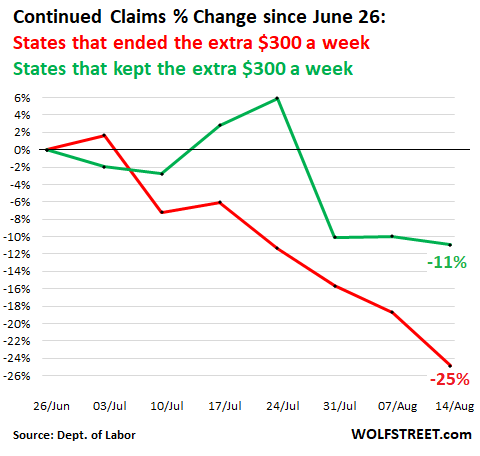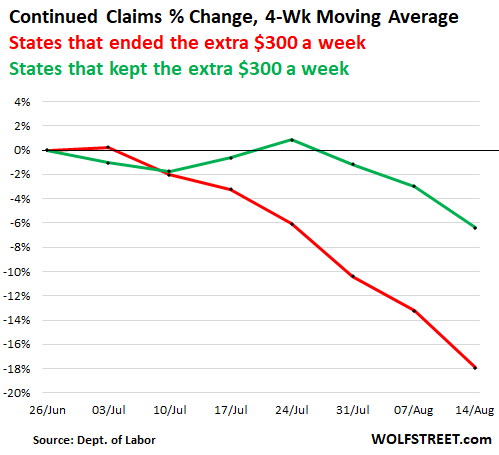August 19, 2021 | The Extra $300/Week Unemployment Benefits Encouraged Many to Not Work: Details about the “Labor Shortage” Pile Up

In the 27 states that have ended the extra $300 a week in federal unemployment benefits, paid on top of the regular state unemployment insurance, people are returning to work at a much faster rate than in states where the extra $300 a week are still being paid: this was further confirmed today by the unemployment insurance (UI) data from the Labor Department.
At the end of June, Texas and Florida joined the group of states that ended the extra $300 a week (the Enders). These states are still paying the regular state unemployment benefits; only the federal top-off $300 a week was ended. Since the end of June, the combined “continued claims” (the number of people having claimed unemployment insurance for more than a week) of the 27 Enders dropped by 25%.
Over the same period, the continued claims by the states that kept the extra $300 a week (the Keepers) dropped by only 11%. In other words, continued UI over just those weeks since the end of June dropped over twice as fast in states that had ended the extra benefits:

For the US overall, “continued claims” dropped to 2.82 million (not seasonally adjusted) in the current week, according to the Department of Labor this morning. It was the lowest since the employment crisis began in March 2020. But it dropped a lot faster among the Enders than among the Keepers.
At the state-by-state level, these “continued claims” serve as a stand-in to determine if ending the extra $300 a week in federal benefits is encouraging people to go back to work.
The “continued claims” data doesn’t cover other forms of unemployment insurance, such as the federal programs for the self-employed (Pandemic Unemployment Assistance) and the federal catch-all program (Pandemic Emergency). But it shows the trends for people who used to be employed, then lost their jobs, qualified under state programs for UI, and have not returned to work by the end of the reporting week.
The four-week moving average irons out some of the week-to-week ups-and-downs that tend to occur in every state, which, when it happens in one of the big states, can skew the national weekly data. Being a four-week moving average, it lags the weekly data, but it shows the trends:

Hiring managers and business owners who need to fill open positions have known this in their gut for months: Paying people as much or more to not work than they made while working encourages them to not work, even though the pay is now higher than it was before.
These hiring managers and business owners have had to struggle for months with this phenomenon of a “labor shortage” that made it very tough to fill open positions even while they were reading the government’s unemployment reports that showed that 11.7 million people still claim some form of UI, as of today’s UI report from the Labor Department.
What will happen when the extra $300-a-week in federal unemployment benefits expire in all states on September 6? We’re getting a pretty good idea: More people will rejoin the labor force and apply for jobs and take jobs and fill open positions, and we should see some strong jobs reports, just in time for the Fed to announced its decision to taper its asset purchases.
STAY INFORMED! Receive our Weekly Recap of thought provoking articles, podcasts, and radio delivered to your inbox for FREE! Sign up here for the HoweStreet.com Weekly Recap.
Wolf Richter August 19th, 2021
Posted In: Wolf Street
Next: WEF Announced They Won »











